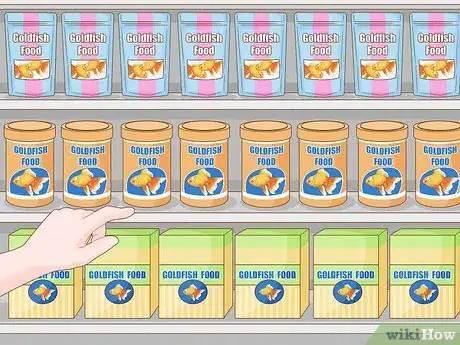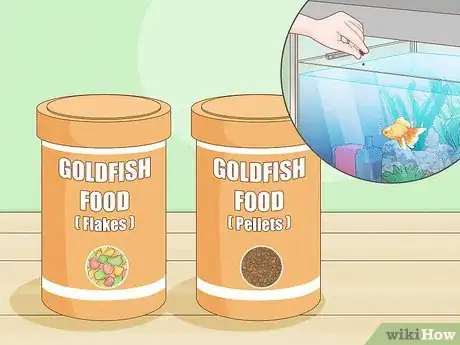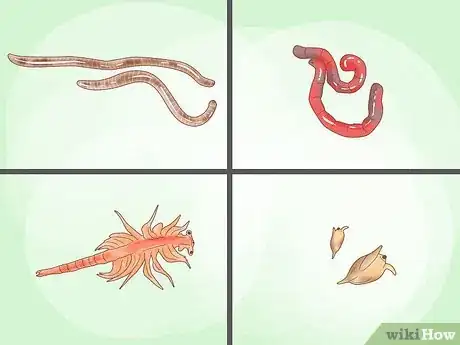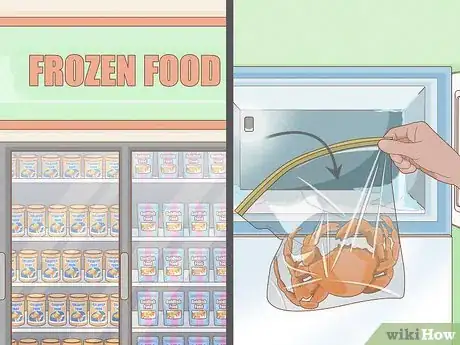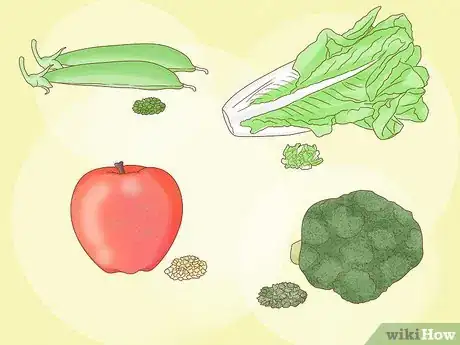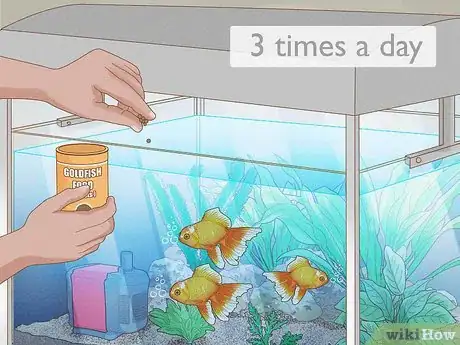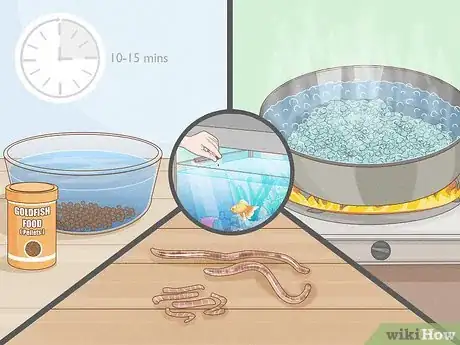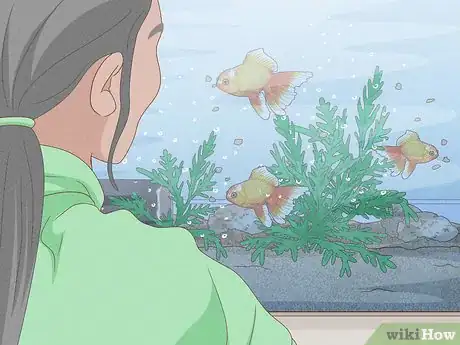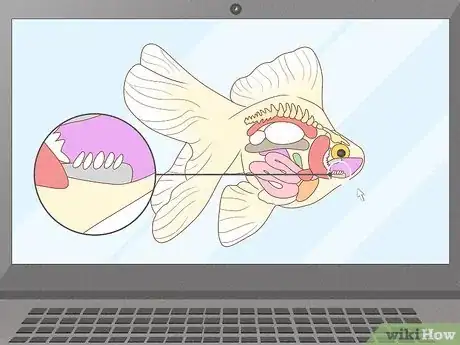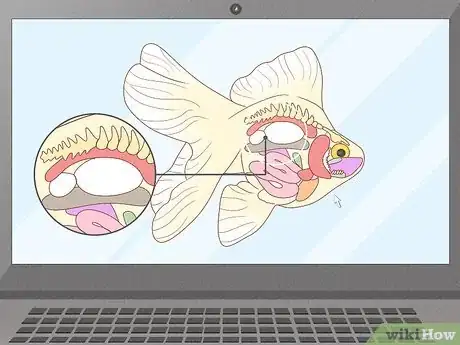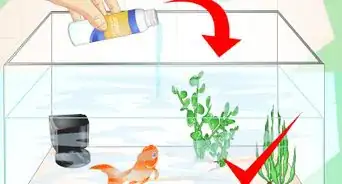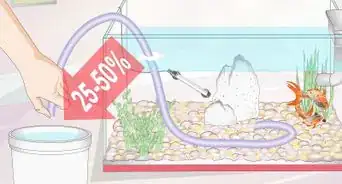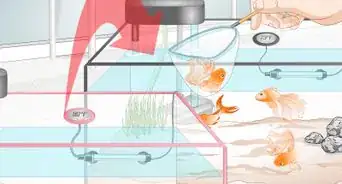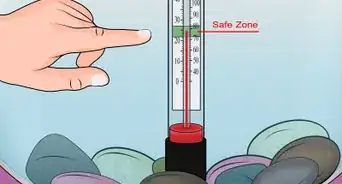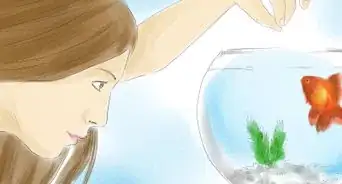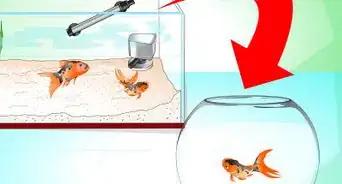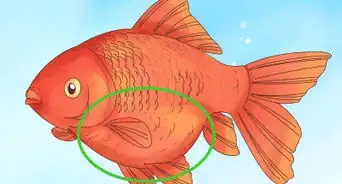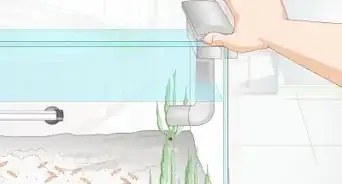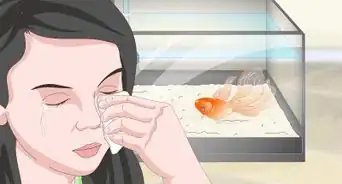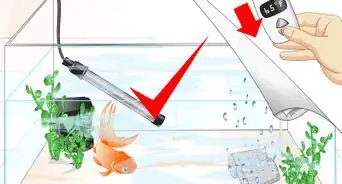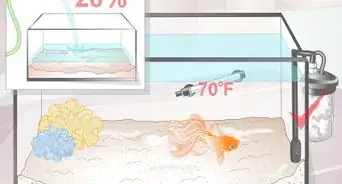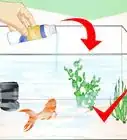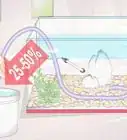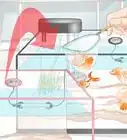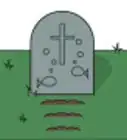This article was co-authored by Doug Ludemann. Doug Ludemann is the owner and operator of Fish Geeks, LLC, an aquarium services company based in Minneapolis, Minnesota. Doug has worked in the aquarium and fish-care industry for over 20 years, including having worked as a professional aquarist for the Minnesota Zoo and Shedd Aquarium in Chicago. He received his Bachelor of Science in Ecology, Evolution, and Behavior from the University of Minnesota.
There are 8 references cited in this article, which can be found at the bottom of the page.
wikiHow marks an article as reader-approved once it receives enough positive feedback. This article has 17 testimonials from our readers, earning it our reader-approved status.
This article has been viewed 295,951 times.
Properly feeding your goldfish is essential to ensuring that he has a happy and healthy life. Overfeeding, feeding the wrong types of food, and not properly preparing the food are common mistakes that goldfish owners will make when trying to feed their fish. Understanding how goldfish eat and what their diet should be will help you feed your goldfish in the right way.
Steps
Learning What to Feed Your Goldfish
-
1Learn what types of food your goldfish should eat. Goldfish are omnivores, which means that they eat meats and plants. There are many types of food that you can feed your goldfish, and it can be overwhelming to go into the pet store and see all of the available options. Before purchasing any food, take some time to learn what the different options are.[1]
- Keep in mind that each type of food has its advantages and disadvantages.
- Your goldfish’s diet should consist of many different types of food. Purchasing different types of food will help you keep his diet interesting and ensure that your goldfish receives all of the nutrients that he needs to stay healthy.[2]
-
2Include dry food in your goldfish's diet. Dry food is one of the most common types of goldfish food. Dry food is usually sold in cans and comes in either flakes or pellets. Flakes will stay at the top of the tank and pellets will typically sink to the bottom. Your goldfish will feed at the top and bottom of his tank, so you can use either type of dry food.[3]
- In general, dry food is fairly healthy for your goldfish, but does not have all of the nutrients that he needs. Because of this, dry food should not be the main component of your goldfish’s diet.
- Since flakes stay at the surface, the excess flakes can be removed easily, making the tank easier to keep clean.
Advertisement -
3Provide different types of live food for your goldfish. Live food is an excellent source of protein for your goldfish, and is considered to be the most important part of his diet. Examples of live food are earthworms, bloodworms, daphnia, and brine shrimp.[4]
- If not prepared properly, live food has the potential to transmit disease to your goldfish. To reduce the likelihood of disease transmission, purchase the live food from your local pet store, rather than searching in lakes, ponds, or the dirt.[5]
- Usually, brine shrimp and earthworms are highly unlikely to transmit disease.[6]
- Earthworms are more available during the summer months, during their breeding season.
- Brine shrimp are very tiny shrimp. They are extremely high in protein, so they should be used as treats rather than a regular part of your goldfish's diet.[7]
-
4Identify frozen and freeze-dried dietary options for your goldfish. Frozen and freeze-dried foods often provide the same level of nutrients as live food.[8] Frozen or freeze-dried foods are also good if you’re a bit squeamish about handling live worms. The live food will most likely be available in frozen or freeze-dried form at your local pet store.
-
5Include small amounts of fruits and vegetables in your goldfish's diet. Fruits and vegetables can be incorporated into your goldfish’s diet. They are a great source of nutrients and are low in fat, but don’t give them a ton of veggies or fruits. Fruits and vegetables that you can feed your goldfish include peas, lettuce, broccoli, and apples.[11]
- Whichever fruit or vegetable you choose, it will need to be softened, cut or diced, and peeled before you feed it to your goldfish. It will also be important not to season the fruits or vegetables in any way.[12]
Feeding Your Goldfish
-
1Feed your goldfish small amounts multiple times a day. A good rule of thumb is to feed your goldfish no more than he can eat in about one to two minutes. Goldfish can literally eat themselves to death, so you need to be very careful that you do not need overfeed your goldfish. Feeding him up to three times a day should be sufficient.[13]
- Grab just enough food that you can easily pinch between your thumb and index finger. This is about the amount of food that you should feed your goldfish.
-
2Know the proper way to prepare each type of food. With the many different types of goldfish food that are available, you will need to know the proper way to prepare each type of food. This will lessen the likelihood that your goldfish will experience digestive upset after eating.
- Pre-soak flakes to prevent your goldfish from swallowing air bubbles when he eats the flakes; swallowing air bubbles can lead to swim bladder problems and constipation. To pre-soak the flakes, dip them in the tank water a few times before fully placing them in the water. Feed them one to two times a week.
- Pre-soak pellets for 10 to 15 minutes, or until they are about twice their original size. Place a small amount of tank water in another container and place the pellets in this container. After they have softened up and increased in size, add them to the tank. Feed the pellets two to three times a week.
- Pre-soak freeze-dried food in a small container of tank water to prevent digestive upset.[14]
- Completely thaw frozen foods before adding them to your goldfish’s tank. Place the food in your refrigerator for the thawing process.
- Peel, chop, and soften fruits and vegetables. Boiling is a good way to soften vegetables. Fruits and vegetables can be given as occasional treats.
- Thoroughly rinse live food if you find it yourself in the environment. Rinsing earthworms with water will help to remove the dirt and potential disease-causing organisms that may be in the dirt.
- To feed worms, cut them into small pieces before putting them in your goldfish's tank; you could even try placing the small pieces on a toothpick and feeding them to your fish that way. Feed the live food once a week.
-
3Observe your fish when you feed him. Pay close attention to your goldfish when you feed him to make sure that he does not overeat. If he has eaten too much, his intestinal tract may become full of food, which would trap gas in his swim bladder and cause him to float aimlessly. If you see him floating like this, immediately remove any remaining food.
- Contact your veterinarian or local pet store for advice on how to treat a goldfish who has overeaten.
-
4Devise a feeding plan if you’ll be traveling. If you will be away from your house for more than a few days, make a plan as to how you want to have your goldfish fed. One option is to have someone feed your goldfish for you. If you choose this option, it would be a good idea to make a detailed list of your goldfish's diet with instructions on how to feed him while you are away.[15]
- Preparing the foods ahead of time and placing them in individual containers may make it easier for whomever will feed your goldfish.
- Automatic fish feeders are also available. Visit your local pet store to learn more about these feeders.[16]
- Keep in mind that goldfish can actually go a long time without eating. Although they will be hungry, goldfish can go up to three weeks without eating.[17]
Understanding Goldfish Anatomy
-
1Identify the location of your goldfish’s teeth. Goldfish do not have teeth in their jaws.[18] Their teeth are located in the back of their throat, which allows them to crush food and swallow food whole.[19] If you listen closely enough, you may actually be able to hear a crunching noise from your goldfish’s teeth as he chews on his food.
-
2Learn about your goldfish's digestive system. Goldfish do not have stomachs. Instead, your goldfish's intestines do the digestive work that a stomach would normally do. In addition, the lack of a stomach means that your goldfish cannot eat much food at a time; the food that he can eat will move quickly through his digestive system.The lack of a stomach makes your goldfish more susceptible to digestive problems if he is not fed properly.[20] [21]
-
3Learn about the purpose of your goldfish's swim bladder. Your goldfish’s swim bladder is an internal gas-filled organ that allows him to stay buoyant in the water. If not fed the proper diet, your goldfish can develop problems with his swim bladder, which means that he would not be able to easily stay afloat in the water.
Expert Q&A
Did you know you can get expert answers for this article?
Unlock expert answers by supporting wikiHow
-
QuestionWhat's the best veggie to give my goldfish?
 Doug LudemannDoug Ludemann is the owner and operator of Fish Geeks, LLC, an aquarium services company based in Minneapolis, Minnesota. Doug has worked in the aquarium and fish-care industry for over 20 years, including having worked as a professional aquarist for the Minnesota Zoo and Shedd Aquarium in Chicago. He received his Bachelor of Science in Ecology, Evolution, and Behavior from the University of Minnesota.
Doug LudemannDoug Ludemann is the owner and operator of Fish Geeks, LLC, an aquarium services company based in Minneapolis, Minnesota. Doug has worked in the aquarium and fish-care industry for over 20 years, including having worked as a professional aquarist for the Minnesota Zoo and Shedd Aquarium in Chicago. He received his Bachelor of Science in Ecology, Evolution, and Behavior from the University of Minnesota.
Professional Aquarist
-
QuestionCan goldish die of overfeeding?
 Doug LudemannDoug Ludemann is the owner and operator of Fish Geeks, LLC, an aquarium services company based in Minneapolis, Minnesota. Doug has worked in the aquarium and fish-care industry for over 20 years, including having worked as a professional aquarist for the Minnesota Zoo and Shedd Aquarium in Chicago. He received his Bachelor of Science in Ecology, Evolution, and Behavior from the University of Minnesota.
Doug LudemannDoug Ludemann is the owner and operator of Fish Geeks, LLC, an aquarium services company based in Minneapolis, Minnesota. Doug has worked in the aquarium and fish-care industry for over 20 years, including having worked as a professional aquarist for the Minnesota Zoo and Shedd Aquarium in Chicago. He received his Bachelor of Science in Ecology, Evolution, and Behavior from the University of Minnesota.
Professional Aquarist
-
QuestionWhat if I want to add variety to their diet?
 Doug LudemannDoug Ludemann is the owner and operator of Fish Geeks, LLC, an aquarium services company based in Minneapolis, Minnesota. Doug has worked in the aquarium and fish-care industry for over 20 years, including having worked as a professional aquarist for the Minnesota Zoo and Shedd Aquarium in Chicago. He received his Bachelor of Science in Ecology, Evolution, and Behavior from the University of Minnesota.
Doug LudemannDoug Ludemann is the owner and operator of Fish Geeks, LLC, an aquarium services company based in Minneapolis, Minnesota. Doug has worked in the aquarium and fish-care industry for over 20 years, including having worked as a professional aquarist for the Minnesota Zoo and Shedd Aquarium in Chicago. He received his Bachelor of Science in Ecology, Evolution, and Behavior from the University of Minnesota.
Professional Aquarist So it's really just easiest to keep them on pellets, or a prepared diet, I should say. Now, the variety in this sense can come in the way of spirulina flakes, flakes versus pellets, or floating versus sinking food. There are a lot of different things that you can do to vary their diet. Just make sure you use food designed for goldfish.
So it's really just easiest to keep them on pellets, or a prepared diet, I should say. Now, the variety in this sense can come in the way of spirulina flakes, flakes versus pellets, or floating versus sinking food. There are a lot of different things that you can do to vary their diet. Just make sure you use food designed for goldfish.
Warnings
- In addition to causing serious digestive and swim bladder problems, overfeeding can lead to problems in your goldfish’s tank. If not removed quickly, leftover food can decay and release harmful toxins such as ammonia into the water. Excess food can also increase the cloudiness of the water, which could cause problems for the tank’s filtration system.[24]⧼thumbs_response⧽
References
- ↑ Doug Ludemann. Professional Aquarist. Expert Interview. 27 August 2019.
- ↑ http://kb.rspca.org.au/what-should-i-feed-my-goldfish_457.html
- ↑ http://kb.rspca.org.au/what-should-i-feed-my-goldfish_457.html
- ↑ http://www.goldfish-as-pets.com/what_to_feed_goldfish.html
- ↑ http://www.goldfish-as-pets.com/what_to_feed_goldfish.html
- ↑ http://www.goldfish-as-pets.com/what_to_feed_goldfish.html
- ↑ http://thegoldfishtank.com/frozen-live-foods-goldfish/
- ↑ http://thegoldfishtank.com/frozen-live-foods-goldfish/
- ↑ http://thegoldfishtank.com/frozen-live-foods-goldfish/
- ↑ http://www.goldfish-as-pets.com/what_to_feed_goldfish.html
- ↑ Doug Ludemann. Professional Aquarist. Expert Interview. 27 August 2019.
- ↑ http://www.goldfish-as-pets.com/what_to_feed_goldfish.html
- ↑ Doug Ludemann. Professional Aquarist. Expert Interview. 27 August 2019.
- ↑ http://kb.rspca.org.au/what-should-i-feed-my-goldfish_457.html
- ↑ http://www.peteducation.com/article.cfm?c=16+2160&aid=3401
- ↑ http://www.peteducation.com/article.cfm?c=16+2160&aid=3401
- ↑ http://www.goldfish-as-pets.com/what_to_feed_goldfish.html
- ↑ http://thegab.org/Articles/GoldfishExternalAnatomy.html
- ↑ http://www.biokids.umich.edu/critters/Carassius_auratus/
- ↑ http://thegoldfishtank.com/do-goldfish-have-stomachs/
- ↑ http://thegoldfishtank.com/do-goldfish-have-stomachs/
- ↑ Doug Ludemann. Professional Aquarist. Expert Interview. 27 August 2019.
- ↑ http://www.goldfish-as-pets.com/what_to_feed_goldfish.html
- ↑ http://www.peteducation.com/article.cfm?c=16+2160&aid=3401
About This Article
To feed goldfish, buy dry pellets or flakes that are specially formulated for goldfish. Dry food should be the main part of their diet. Offer your fish small amounts of dry food about 3 times a day and try not to give them any more than they can eat in about 1-2 minutes. In addition to dry food, supplement your goldfishes’ diet with treats, such as live bloodworms or brine shrimp. You can also feed them frozen shellfish and small pieces of vegetables, such as chopped-up peas or shredded lettuce. Always thaw frozen food before feeding it to your fish. Some experts also recommend pre-soaking pellets or flakes to soften them and make them easier to eat. For more advice from our Veterinary reviewer, including how to supplement your goldfish’s diet with fruits and vegetables, keep reading.
